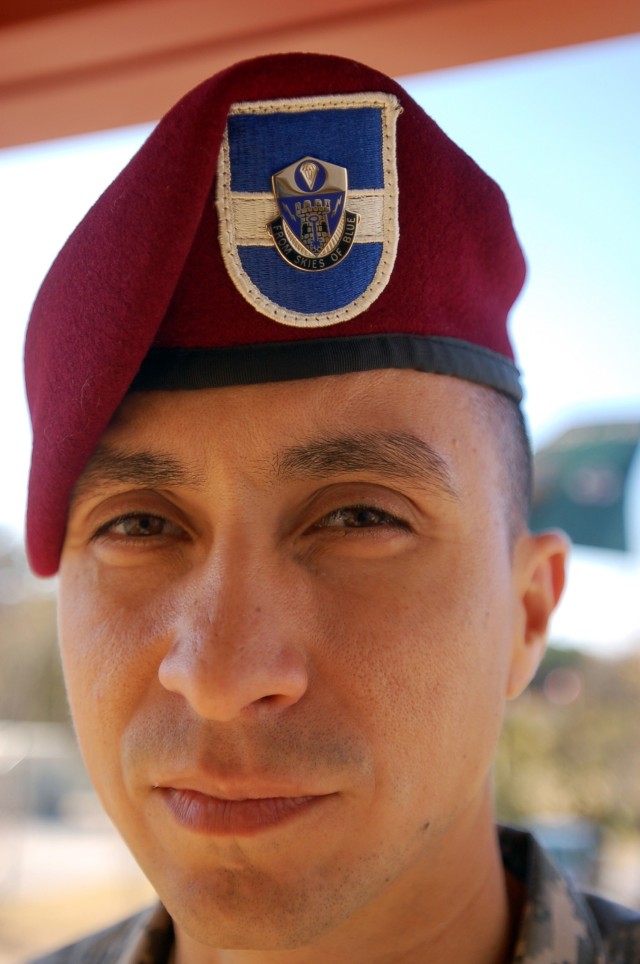FORT BRAGG, N.C. (Army News Service, Nov. 21, 2006) - Unit crest designs symbolize units' traditions, history and specialties. Some have been around for almost a hundred years and their original designers are long forgotten.
When members of the 2nd Brigade Combat Team's 325th Special Troops Battalion pin their distinctive unit insignia crest onto their berets, they can thank Spc. Kreg Paul for designing it.
Paul, 26, from Halifax, Pa., is an Arabic translator with Company B, 325th STB, 2nd BCT, 82nd Airborne Division. He almost single-handedly designed the new crest that his battalion currently wears.
Paul's involvement in the design of the crest started late one night in 2005 when he was pulling duty as charge-of-quarters runner. It was 5:30 a.m. and he was struggling to stay awake when he heard the battalion sergeant major discussing something in his office. Paul listened in, something that comes naturally to him.
"My job is basically eavesdropping," he said.
At the time, Paul belonged to the 313th Military Intelligence Battalion. The 313th was on the verge of transforming into the 325th STB, and Command Sgt. Maj. Mark Warner was discussing how to come up with a design for the unit's new crest. Paul, who has a background in graphic design, volunteered to tackle the problem himself.
"I figured at the very least it would help keep me awake for the next few hours," he said.
The unit had already come up with a dozen designs which had been rejected for various aesthetic reasons. Staff Sgt. Michael Thornsberry, then the battalion's training noncommissioned officer, had helped with some of the earlier versions.
"We'd have something and then someone would come along and say, "Well, what if we turn the lightning bolt around' And we'd have to start all over," he said.
Paul's only guidance was that the crest should have an airborne theme, be associated with the brigade and incorporate elements from each unit in the battalion - military intelligence, engineers, signal, chemical and military police.
"It was difficult because of the sheer amount of stuff you need on a crest that incorporates all these different units," he said.
One of Paul's first designs used a mix of the colors traditionally associated with the different units. He wasn't happy with the results.
Next he tried combining the different branch symbols, such as the engineer's castle and the scales of justice of the military police. When he found a suitable way to combine them, Paul's next challenge was to make the crest similar to the crest of the 325th Airborne Infantry Regiment, the STB's parent unit.
"The idea was to keep the same shield design and incorporate other elements of the 325th AIR's crest. Since we're organic to the unit, (having similar-looking) insignia is something that will tie us to them," he said.
Those considerations led Paul to settle on a final design with classic, traditional features similar to the 325th AIR's crest.
The final design is a silver shield with a blue disc on the top with a parachute symbolizing airborne proficiency. The center of the shield is a blue fess illustrative of the 325th AIR's colors. At the bottom of the shield, a key represents military intelligence, lightning bolts signify the Signal Corps, a triple-turreted castle stands for the Corps of Engineers, the scales of justice express the mission of the military police and a ring of fire symbolizes the Chemical Corps. Attached below the shield is a silver scroll inscribed "From Skies of Blue."
"As soon as they saw that one, that's the one they wanted," said Thornsberry.
Before anyone could wear Paul's design, it first had to be approved by the Army's Institute of Heraldry. It was a slow process that lasted until summer 2006. By then, Paul had deployed to Iraq, where he now wears a Kevlar helmet instead of a beret.
But back in garrison, everyone in the STB is wearing the crest, and when Paul redeploys, he said he will wear his beret with special pride.
"It's pretty cool to be able to wear the crest I designed," he said. "I've never met someone who designed a crest before. Most people who have, probably did it back in World War II."
Paul said he is proud to have played a role in shaping something that will outlast him.
"It's a concrete legacy. No matter what I do in my career in the military, there's always going to be this," he said.


Social Sharing